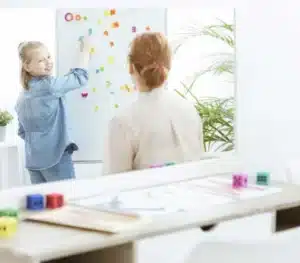By Angela Kurdzhukyan MS, OTR/L
1) The first step in the early intervention timeline starts with the identification of a problem:
- A problem is identified by parents, physicians, community agencies, occupational therapists, and other health providers. A referral is then made to the local Regional Center
- Premature birth and complications can be associated with this stage to ensure that newborns stay up to date with their milestones
- Brain development is the most crucial in the early years and services provided early on in a child’s development can lead to improvements across all domains (e.g cognition, gross motor, fine motor, adaptive, social)
- *Professionals need verbal approval from parents to make a referral
2) The evaluation process:
-
- There are many laws/regulations associated with the evaluation process that providers should be aware of
- An evaluation must:
- Be completed in 45 days from the referral
- Be in the family’s native/preferred language
- Assess motor, cognitive, social-emotional, communication, and adaptive development
- An evaluation should:
- Include observation of a child in their natural environment
- Include the child’s age, gender, ethnicity, culture, and needs of the family/team
- Include parent interview
- Include an ecological evaluation (this is used to determine the skills that a child will need to succeed across different environments)
3) Determination for eligibility
- Determination for eligibility is dependent on qualifications under state criteria
- Typically, a child may become eligible if they are experiencing developmental delay or are diagnosed with a physical or mental condition that has a high chance to lead to a developmental delay
4) Service coordinator
- If eligible, a service coordinator is appointed that serves as a consultant for parents for services provided
5) Development of an Individualized family service plan (IFSP)
- After determination of eligibility an IFSP is established
- The IFSP includes:
- Child and family information (date of birth, contact information, basic details)
- The child’s current status/present level of development
- Physical skills (reaching, crawling, walking, drawing)
- Cognitive skills (thinking, problem solving)
- Communication skills (talking, listening, understanding)
- Self-help/adaptive skills (eating, dressing)
- Social/emotional skills (playing, interacting with others)
- Family concerns, priorities, and resources
- Expected measurable outcomes
- Service types, providers, frequency, duration, and dates
- Service coordinator information
- Description of natural environment services will be provided in
- Need for additional services
- Steps to transition at the age of 3
- Parent/guardian consent
- An IFSP is reviewed every 6 months and must be evaluated once a year
6) Interventions
- Interventions may be completed in an interdisciplinary team that may include occupational therapists (OTs), speech language pathologists (SLP), physical therapists (PT), nurses, audiologists, case managers, and family.
- Services should promote skill development, family education, and address transitioning
- OT interventions in early intervention may additionally place emphasis on feeding and sensory integration
- Intervention typically takes place in naturally occurring environments such as the child’s home, park, grandparents’ home, or daycare (see below for more)
7) Transitioning
- After a child turns three, they may transition to a school, private preschool, childcare center, head start, or other community service
- Referrals to other programs should be made at least 6 months prior to the child turning three
Focus of intervention: Why natural environments?
- Learning in a natural environment appears to be the most effective for addressing developmental needs of younger children
- Children are more comfortable in familiar settings such as their home
- By providing early intervention services in natural environments practitioners take advantage of the actual context that occupations occur in
- These real-life settings promote the child’s acquisition of functional skills and increase the likelihood that the skills will generalize to other environments/activities
- Within the natural environment, incidental learning can be used to teach children new skills or help them master developing skills
- Through incidental learning therapists can follow the child’s lead and use natural interactions that occur in a child’s typical routine
- Example of incidental learning: Brad is in the middle of playing with toys in the pool but is hesitant to go inside the pool due to tactile sensitivity (wet shorts). He is observed to sit down on the concrete around the pool to reach over for the toys inside the pool. Using incidental learning a caregiver or therapist adds small amounts of water to the sides of the pool in order to get Brad’s shorts slightly wet. This follows the Brad’s lead in play, is not intrusive, and can slowly desensitize Brads sensory system.
Uplift Therapy Center is an approved vendor with Frank D. Lanterman Regional Center (FDLRC) for Early Intervention Services in Occupational and Speech Therapy. FDLRC covers Hollywood-Wilshire, Central Los Angeles, Pasadena, Glendale, Burbank, La Cañada, and La Crescenta areas.




